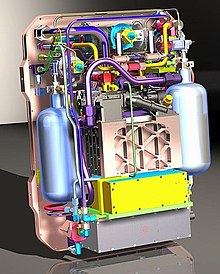Z series space suits
This article needs to be updated. (March 2019) |

The Z series
Along with a NASA designed life support system, the new higher pressure Z suits allow for bypassing pre-breathe and allows for quick donning of the suit and exit of the space craft. The Z-1 is the first suit to be successfully integrated into a suitport dock mechanism eliminating the need for an air lock, and reducing the consumable demands on long term missions. A later variant is planned to be tested on the International Space Station in 2017.[2]
Versions
Z-1
The Z-1 suit consists of a soft upper torso, soft lower torso, glove assembly, boot assembly and hemispherical dome helmet.[1] Z-1 is called a "soft" suit because when unpressurized its primary structures are pliable fabrics, although it does have several hard mobility elements.[1] The suit has a mass of 126 pounds (57 kg), with the suitport interface plate (SIP) it is 154 pounds (70 kg), and with the SIP and portable life support system (PLSS) mock-up it is 162 pounds (73 kg).[1][3]
The Z-1 prototype was designed and built by
NASA has been running a series of tests on the Z-1. According to a NASA report there have been two parts of the testing 1) characterize the suit performance to down selection of components for the planned Z -2 Space Suit and 2) "develop interfaces with the suitport and exploration vehicles through pressurized suit evaluations."[7]
-
Z-1 Spacesuit Prototype - kneeling demonstration (November 2012)
-
Suitport tests with the Z-1 suit
-
Z-1 suit being tested during aparabolic flight
Z-2
This article needs to be updated. (April 2016) |

Both ILC Dover and David Clark competed for the $4.4 million contract to design, manufacture and test the Z-2 prototype space suit.[8][9] In April 2013, it was announced that ILC Dover had won; the contract is expected to last for an 18-month period.[9]
The Z-2 will use a
The Z-2 prototype suit was expected to be delivered to NASA by November 2014 with a
Portable life support system

The Next Generation Life Support (NGLS) project is developing components that are planned to be part of the
The VOR is expected to allow the suit pressure to be adjusted to 84 settings between 0 and 8.4 psid.[15] The current Extravehicular Mobility Unit (EMU) only has two pressure settings.[15] This new capability will enable in-suit decompression sickness treatment and flexibility for interfacing with different vehicles.[15] It also allows EVAs to start at a higher internal pressure to decrease prebreathe time, and then slowly decrease the pressure afterward in order to maximize mobility and minimize crew fatigue.[15]
The RCA swing bed removes carbon dioxide (CO2) and controls humidity.[15] The RCA CO2 removal capability is regenerated during EVA by exposure to vacuum, making it superior to previous systems.[15] To remove CO2, the current EMU has to use either a lithium hydroxide (LiOH) canister or a Metal Oxide (Metox) canister.[15] The LiOH canister can only be used once.[15] The Metox canister can be reused post-EVA but to do so takes fourteen hours and requires auxiliary equipment, crew time and significant electricity.[15] RCA is expected to weigh less than current comparable systems.[15]
References
- ^ a b c d Robert M. Boyle; Liana Rodriggs; Charles Allton; Mallory Jennings; Lindsay Aitchison (1 January 2012). "Suitport Feasibility - Human Pressurized Space Suit Donning Tests with the Marman C lamp and Pneumatic Flipper Suitport Concepts" (PDF). NASA. Retrieved 25 June 2013.
- ^ Popsci, The Deep-Space Suit Retrieved on 2012-12-21.
- ^ Ross, Amy (1 June 2012). "Z-1 Prototype Space Suit Testing Summary" (PDF). NASA. Retrieved 25 June 2013.
- ^ Delaware Business Daily, Z-1 Top Tech.Retrieved on 2012-12-21.
- ^ Best Inventions 2012, NASA’s Z-1 Space Suit Archived 2015-02-20 at the Wayback Machine. Retrieved on 2012-12-21.
- ^ "NASA's Z-1 Spacesuit: Buzz Lightyear's Duds (Photos)". space.com. Retrieved 21 June 2016.
- ^ NASA Technical Reports Server, Z-1 Prototype Space Suit Testing Summary. Retrieved on 2012-12-21.
- ^ Space News. 26 April 2013. Retrieved 28 January 2023.
- ^ a b c d "NASA Awards Z-2 Spacesuit Contract To ILC Dover". ILC Dover. 19 April 2013. Retrieved 29 April 2013.
- ^ Sloan, Jeff (10 November 2016). "On Mars, not just any suit will do". www.compositesworld.com. Retrieved 28 December 2017.
- ^ a b c d "Z-2 Spacesuit Design Vote". NASA. Archived from the original on 25 March 2014. Retrieved 29 March 2014.
- ^ a b "Advanced Suit Development Team - Reddit AMA". 26 March 2014. Retrieved 29 March 2014.
- ^ "Extravehicular Activity (EVA) Spacesuits". ILC Dover. April 2013. Retrieved 29 April 2013.
- ^ a b "Ultimate wearable tech: NASA using 3D printing to design Mars spacesuit - TechRepublic". techrepublic.com. Retrieved 21 June 2016.
- ^ a b c d e f g h i j Barta, Daniel (15 July 2012). "Next Generation Life Support Project: Development of Advanced Technologies for Human Exploration Missions" (PDF). American Institute of Aeronautics and Astronautics. Retrieved 25 June 2013.



